Today only few natural whetstones are made in Europe.
The gathering or chopping, sawing and sanding of pieces of stone from the rock are time-consuming and unhealthy activities, which are being carried out by fewer and fewer companies. The market is flooded by Japanese and Chinese synthetic whetstones that push the natural stones to a margin. There are (to my knowledge) only five professional creators of natural whetstone in Europe. The Slovakian Rozsutec whetstone , the least known of those stones, seemed to be no longer being actively produced for some time. This stone is mainly known to users of classic open razors, but deserves more applications because of its versatile nature. It seemed that the Rozsutec whetstone would disappear when its last maker, Lubomír Krivoš, who had no successor (info Henk Bos), passed away in 2013.
Fortunately and by chance, I found a new sign of life about this stone. Lubomír’s son Marian and daughter Monika have picked up the thread with the knowledge and tools from their father. That was a very good reason for me to pay a visit.
The Rozsutec: a whetstone from a heroic age, that is kept from extinction by two modern heroes.
If you read this article, you will probably be familiar with the best-known European natural whetstones. The Belgian chunk (Coticule), the Dragon’s Tongue from Wales, the Lombard (Opinel) from the Italian Alps and the French Pierre Naturelle des Pyrénées.
The Rozsutec whetstone from the Slovak Mala Fatra is less known. But exactly this stone can offer added value to any sharpening process due to its versatility and yet specific properties.
A little history
Slovakia is not quite popular with us. It has a lot to offer to tourists, but I have only found one travel book about Slovakia. We Dutch people don’t travel there. Too far away, unknown language, a hint of the former Eastern bloc, you name it. You’ll be better of sleeping in France. However, Slovakia belongs to the European Union, falls within the Schengen Convention, is easily accessible and just as close to the netherlands as the south of France or Italy.
My interest in Slovakia once started with the knowledge that natural whetstones were extracted there. After some googling, the stone appeared to be found at the foot of the Veľký Rozsutec mountain in the Mala Fatra nature park. It has been known for centuries as a very fine polishing whetstone and is still very popular with users of classic open razors. What we do not yet know is that the stone is capable of much more.
 An important history is associated with the mountain and the whetstone. Slovak hero Juraj Jánošík, who stole from the rich and donated to the poor, sharpened his ax on this stone, hiding in the gorges of the Mala Fatra. He and his ax are a permanent part of Slovak identity. His 7.5-meter-high sheet-iron statue is the eye-catcher in his native Terchová. Everything that is associated with him is practically sacred, including the Rozsutec whetstones. The fact that he sharpened his ax onto this stone indicates that the stone is capable of much more than just fine polishing. For example, in the Carpathians and the Austrian Alps, the stone is very popular for the final stage of sharpening of scythes, which are still frequently used on the slopes a mechanical lawn mower can not reach.
An important history is associated with the mountain and the whetstone. Slovak hero Juraj Jánošík, who stole from the rich and donated to the poor, sharpened his ax on this stone, hiding in the gorges of the Mala Fatra. He and his ax are a permanent part of Slovak identity. His 7.5-meter-high sheet-iron statue is the eye-catcher in his native Terchová. Everything that is associated with him is practically sacred, including the Rozsutec whetstones. The fact that he sharpened his ax onto this stone indicates that the stone is capable of much more than just fine polishing. For example, in the Carpathians and the Austrian Alps, the stone is very popular for the final stage of sharpening of scythes, which are still frequently used on the slopes a mechanical lawn mower can not reach.
Rozsutec characteristics
 The Rozsutec whetstone is a hard sandstone that is extracted from a single quarry in the karst mountains of the Mala Fatra, below the slopes of the Veľký Rozsutec. The stone was naturally created from layered deposits of fine sand that were compressed into hard sandstone slabs. It is blue in nature, but it turns brown on the top and bottom of each plate due to corrosion. This creates the typical appearance, a brownish stone with a central blue band.
The Rozsutec whetstone is a hard sandstone that is extracted from a single quarry in the karst mountains of the Mala Fatra, below the slopes of the Veľký Rozsutec. The stone was naturally created from layered deposits of fine sand that were compressed into hard sandstone slabs. It is blue in nature, but it turns brown on the top and bottom of each plate due to corrosion. This creates the typical appearance, a brownish stone with a central blue band.
The Rozsutec whetstone is, as already said, very fine and very hard. It hardly ever wears in use. The grit value is between 6,000 and 8,000 (JIS), which is mainly maintained because the grinding sand grains do not break out during use, but are topped off, leaving a smooth surface. In that sense, the Rozsutec is very similar to the hard natural whetstones from Japan and the American Arkansas stones. A new Rozsutec whetstone feels very smooth and becomes even smoother through use. It is not an aggressive stone, but it slowly polishes the knife blade until it shines like a mirror and the blade’s cut is incredibly sharp. This property makes it extremely suitable for razors and the finish of chisels and gouges, but hard modern kitchen knives also benefit.
On the other hand, you can also use a Rozsutec whetstone as a more agressive sharpening stone with a less polished result. You need to roughen it with sandpaper to do that. Due to its hardness, it will retain this abnormal effect for a long time. In the end, it will return back to the smooth hone, less grinding and more polish, but this ‘adjustability’ makes it very versatile. In that sense it is unique and not comparable to any other whetstone.
The finding spots
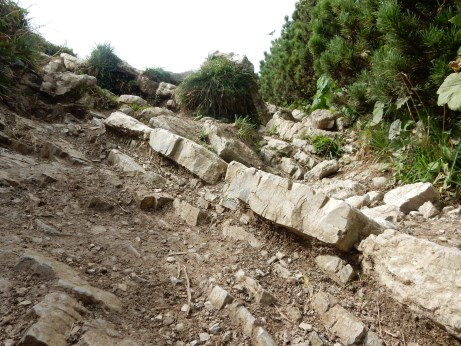 Actually it is quite weird that the whetstones are harvested in only one quarry, because the entire region is littered with Rozsutec rock layers. The stone is literally everywhere for the taking, so if you are in the area, take a cart with you on your hikes. Like the locals, who frequently use it for walls, gardens, furnaces, fireplaces, street tiling, gravel paths etc. The stones from the many other quarries in the area are not used at all as a whetstone, but only for those kind of applications.
Actually it is quite weird that the whetstones are harvested in only one quarry, because the entire region is littered with Rozsutec rock layers. The stone is literally everywhere for the taking, so if you are in the area, take a cart with you on your hikes. Like the locals, who frequently use it for walls, gardens, furnaces, fireplaces, street tiling, gravel paths etc. The stones from the many other quarries in the area are not used at all as a whetstone, but only for those kind of applications.
This also applies to almost all natural whetstones in the world. Whetstones are almost always by-products from quarries. From the famous, but now closed, Thuringer quarries, mainly roof tiles and graphite pencils were made. In the UK entire villages were built from the now very expensive Charnley Forest. And in Wales you can sharpen your knives on any headstone or nameplate made from the same slate slabs as the Dragon’s Tongue.
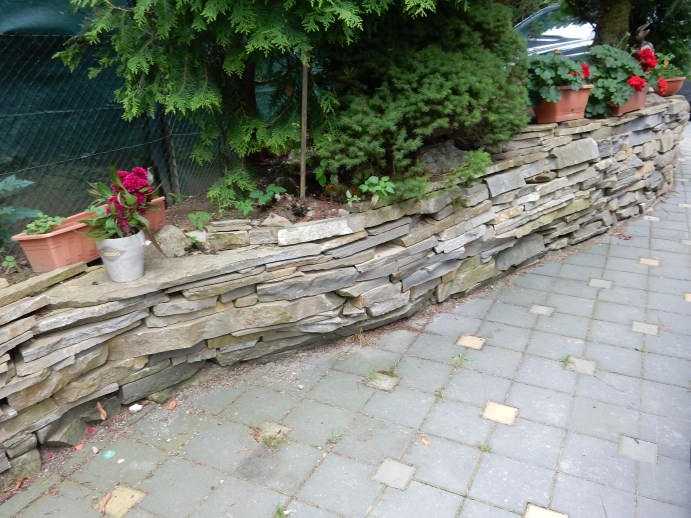
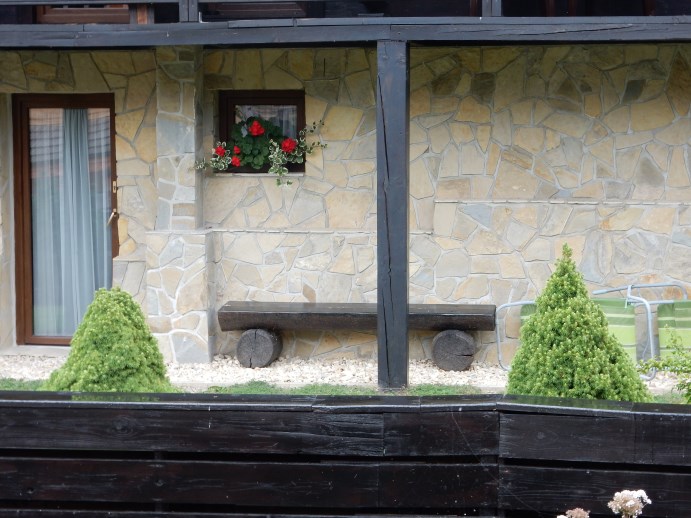
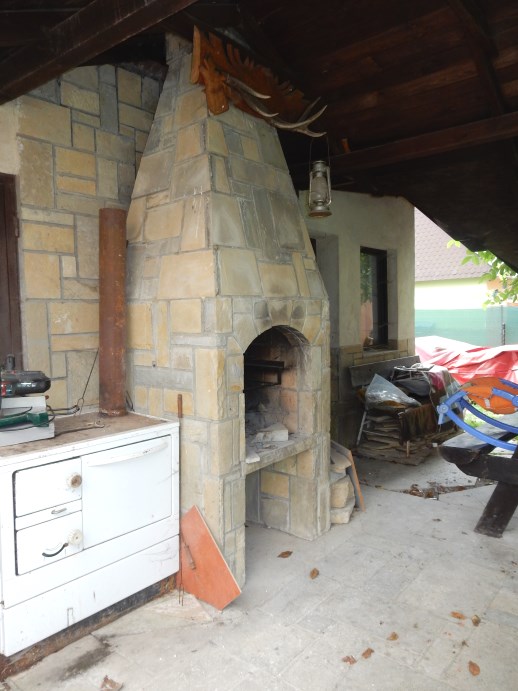

The heroes
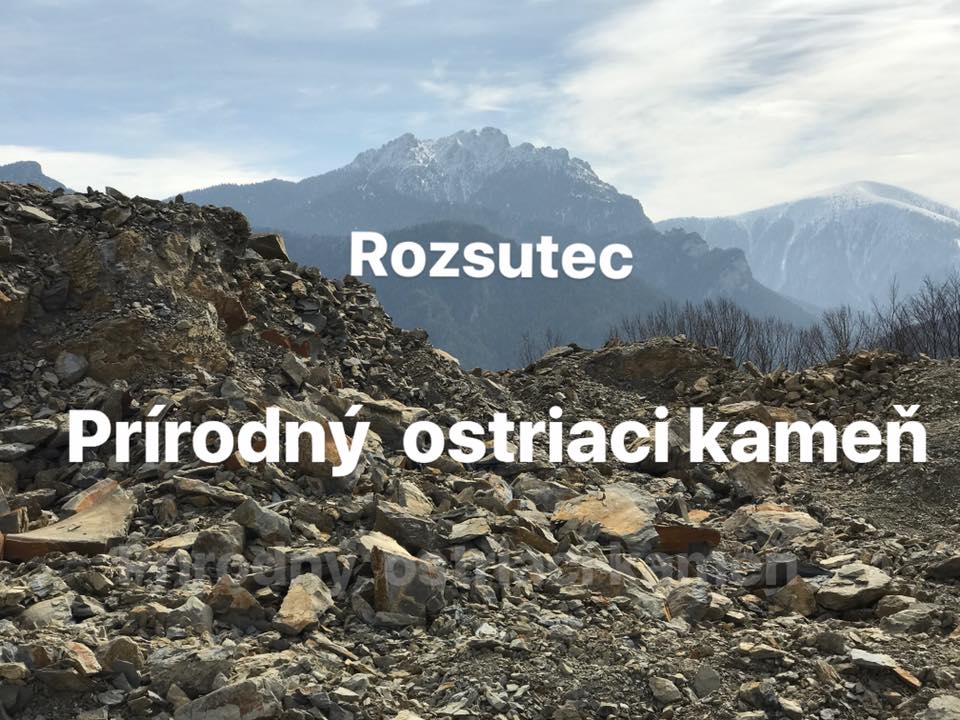
In search of the Rozsutec, I found the very last whetstone maker in Slovakia, in Terchová, at the foot of the Rozsutec mountain, after which the stone was named.
Together with his sister Monika, Marian Krivoš runs the last whetstone company in the area, coincidentally near the birthplace of Juraj Jánošík. Their business is located in the parental home, where they live with Monika’s two children, a cat and a dog, and work on part of their income, making and selling the Rozsutec whetstone.

Marian and Monika are the children of Lubomir Krivoš. He was the last of a generation of whetstone makers in Slovakia, and with his death in 2013, the entire whetstone production in Slovakia seemed to be dying out. Fortunately the workspace and equipment were still in order, so the business could be continued. I am so glad they did, because not only a good whetstone will be available, but they also, probably without knowing themselves, rescue an important cultural tradition against all odds. This is why I call them heroic.
Marian is responsible for the stone production and Monika takes care of sales, administration and correspondence. The shed behind their home is divided into different workspaces, separated by walls and plastic screens that ensure that the frequently occurring dust clouds do not spread throughout the neighborhood. The kitchen is used to pack and prepare the stones for shipping.
Quarry
The quarry is situated on a hill, one kilometer outside of Terchová. The quarry can only be reached by a narrow mountain road, just wide enough for the small antique truck that Marian uses to transport the stones to the valley. Due to a broken toe I was unable to walk to the quarry and unfortunally also the camper was not an option, but I was able to score some pictures.
Marian carefully selects the rough stone plates that are suitable for whetstones from that one quarry.
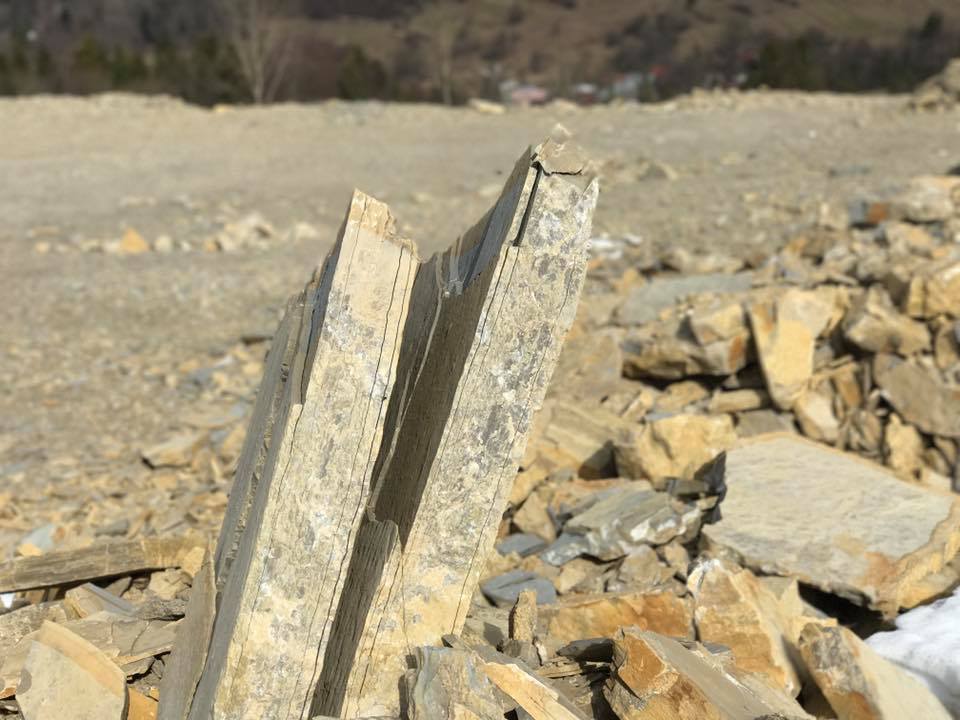
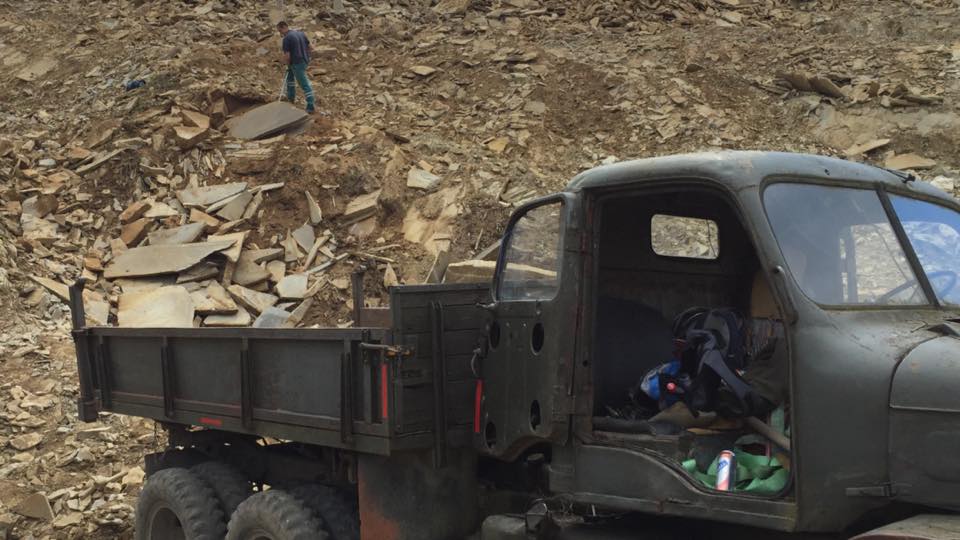
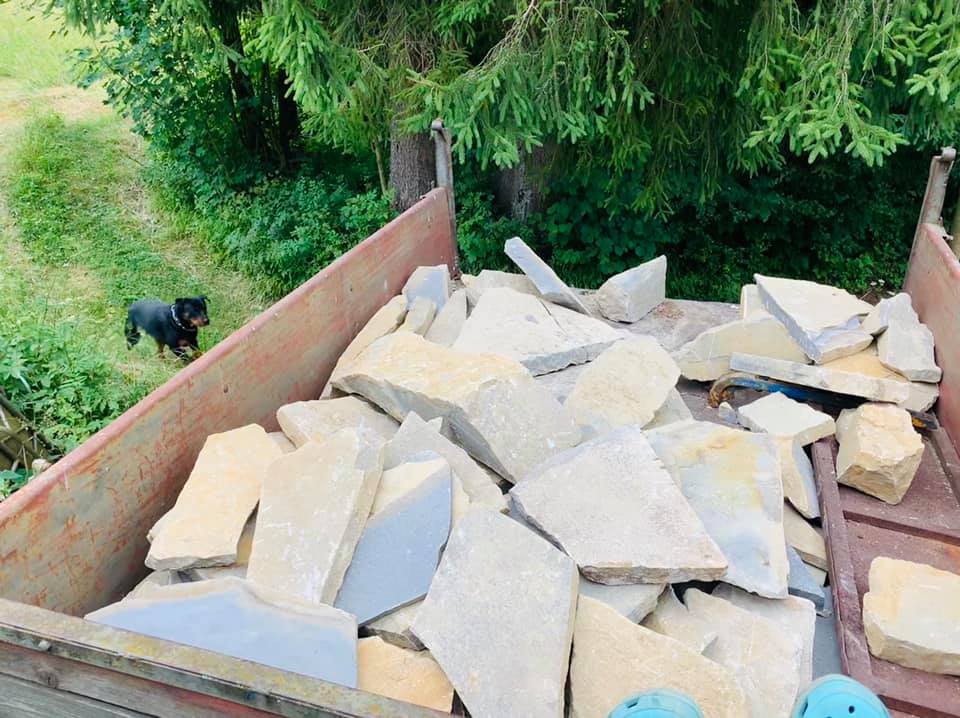
The quarry itself is not owned by brother and sister Krivoš. This implies that they cannot collect large amounts of stone for other use like building material, but depend on the owner’s favors. The whetstone business is a second source of income for them, besides to a street restaurant, where you can get damn tasty kebabs by the way.
The activities needed to create a whetstone
A good slab to make whetstones must be homogeneous, without inclusions of other stone, chalk or other materials. To be able to saw it, it must be only a few inches thick. There should not be any cracks, as shown in the first photo above, because then the sawn whetstones will fall apart. The thickness also determines how wide or high the whetstones become, so too thin is not good either.
Second inspection
After collection and transport home, the raw plates are checked again before they are processed into whetstones.
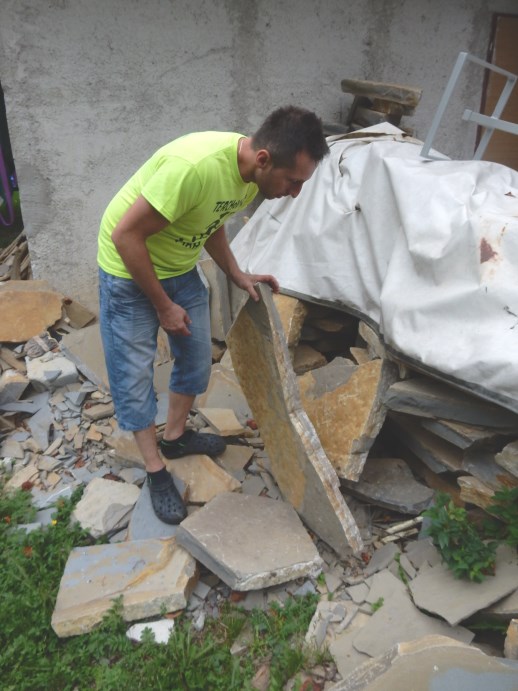
Sawing
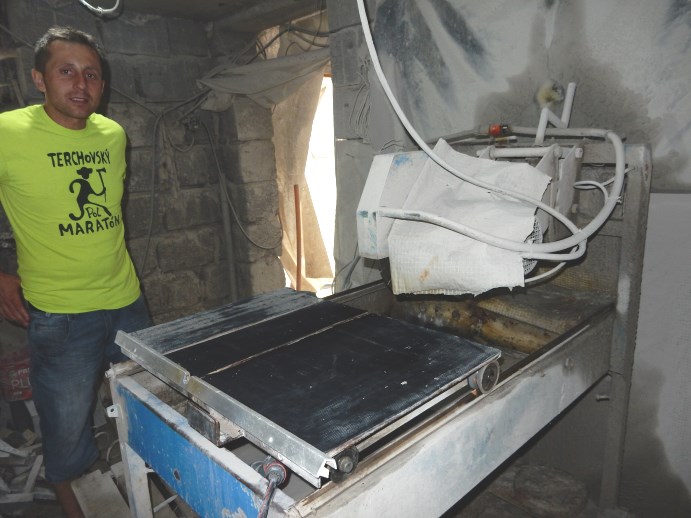
A good slab is cut into rectangular pieces with a diamond saw. A pretty dusty job, but the saw is cooled with water. As a result, a constant stream of ‘mud’ runs through a gutter in the workspace during sawing, something that I had not taken into account when I stepped back during our tour.
Flattening and polishing
The rough sawn whetstones have an irregular and rough surface. They therefore still have to be ‘flattened’ with a rotating (emery) grindstone. This is quite easy for a rectangular bench stone, but for a cigar-shaped scythe stone or other deviant shape it is something else. Marian makes whetstones in large quantities for the fine grinding of scythes, which are still frequently used on slopes that no mower can reach.
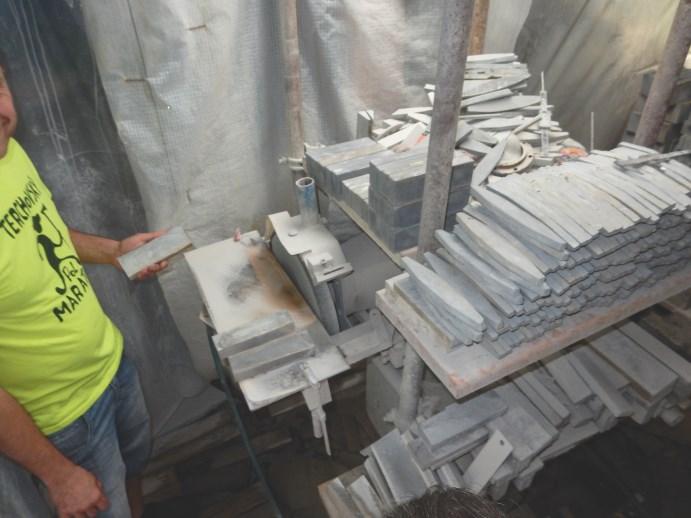
Finally, the stone undergoes a second grinding, polishing the rough surface until it is smooth. This property ensures that the scythe or the knife gets a smooth, shiny cut. Then just put a stamp on it, pack and ship it.
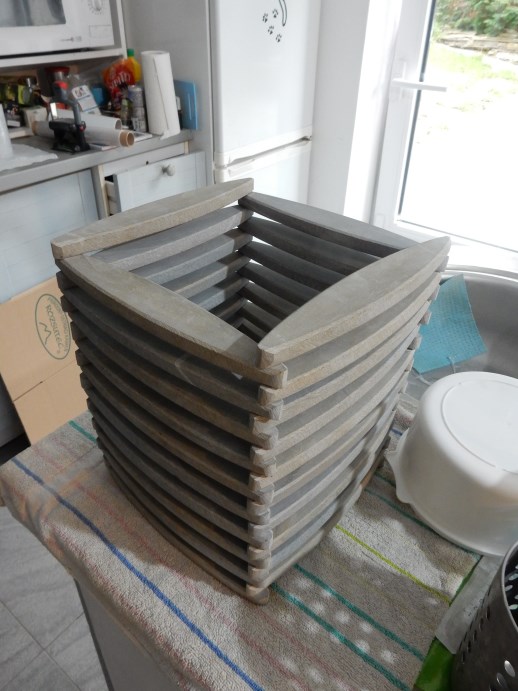
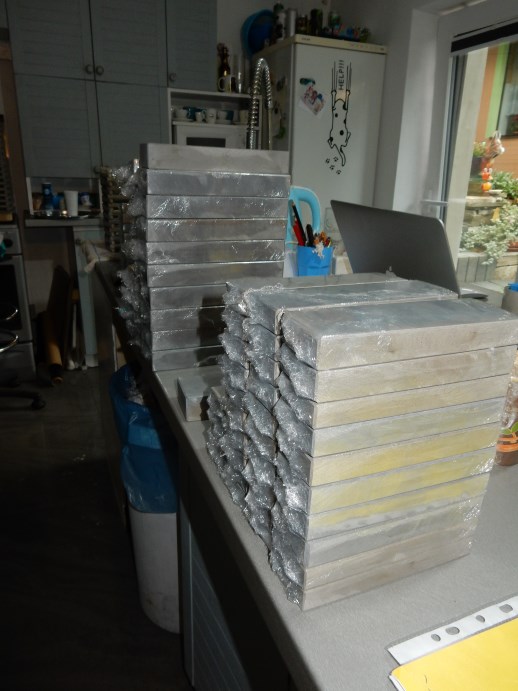
Now how about using the Rozsutec?
A Rozsutec must be used with water. The stone is hard and hardly wears. No abrasive grains are released, which implicates a Rozsutec being relatively slow. This also keeps the surface smooth, which makes the stone very suitable for very fine polishing of already ground steel. And by polishing the sharp edge of a knife, scythe or whatever will go along it becomes even sharper. The latter is also possible with a good very fine-grained synthetic whetstone, but that costs a multiple factor of a Rozsutec.
With a Rozsutec whetstone you can sharpen very well in the traditional Japanese way. You’ll only need one or more naguras for this, which you rub on the Rozsutec to get the desired slurry. The Rozsutec does about the same as a Japanese natural whetstone, but is a lot-many-multiple cheaper. A Rozsutec has, for the connoisseur, roughly Lv5 hardness and is therefore a ‘sharpening table’ that is always flat.
Finally, you can train a Rozsutec into a stone with more aggression and less polishing. The surface, which is supplied smooth, can be roughened with rough sandpaper. Due to its hardness, you can then sharpen a knife at a reasonable speed. In this condition, the Rozsutec is very suitable for pruning shears, lawn mowers, scythes and axes.
But whatever you do with this versatile stone, it will always remain relatively slow. The sand that composes this stone has a hardness of 7 Hrc. The abrasive grains of a synthetic stone are usually around 8 or 9 HRC, depending on the quality (and price!). In contrast, the result of a Rozsutec is always ‘softer’. The stone does not create deep scratches and the cut of your knife will become razor sharp and super smooth. And in that sense it surpasses most of his competitors. So this is a big plus!
Conclusion
D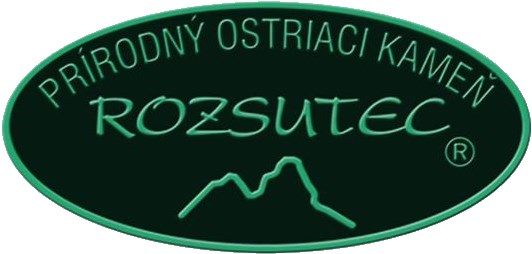 uring my visit I met two enthusiastic people who deserve their work to be appreciated by lots of enthusiastic users around the world. At the same time I realize that the privilege I had to visit them is not accessible to everyone. If you have become interested in the Rozsutec whetstone, you can order it directly from http://rezkam.sk/eshop.php. Monika will correspond in perfect English.
uring my visit I met two enthusiastic people who deserve their work to be appreciated by lots of enthusiastic users around the world. At the same time I realize that the privilege I had to visit them is not accessible to everyone. If you have become interested in the Rozsutec whetstone, you can order it directly from http://rezkam.sk/eshop.php. Monika will correspond in perfect English.
You can also purchase the stone from deMessenslijper.nl. Send a message in which you indicate what you want to do with it, then I will help you choose the right one and take care of the order.
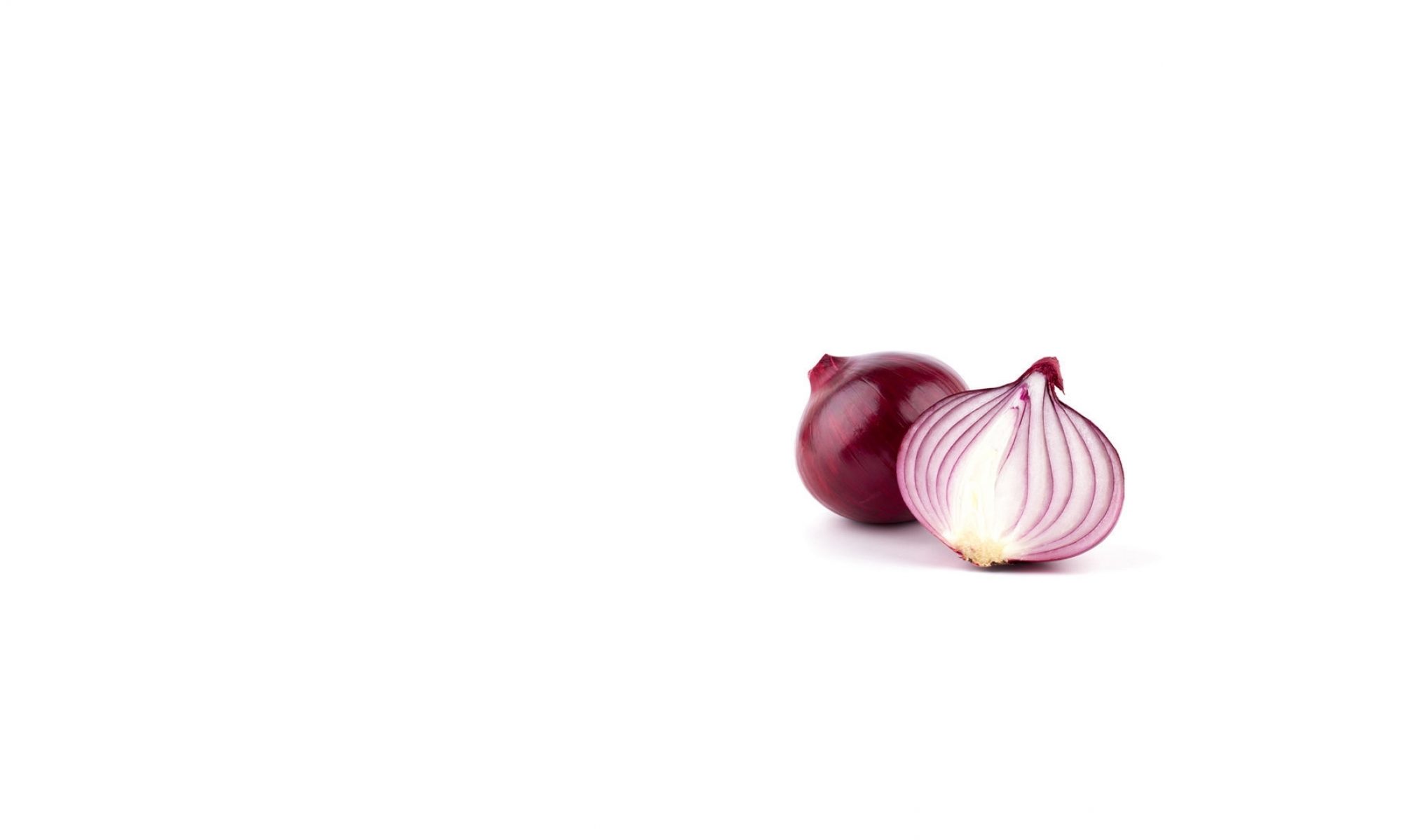

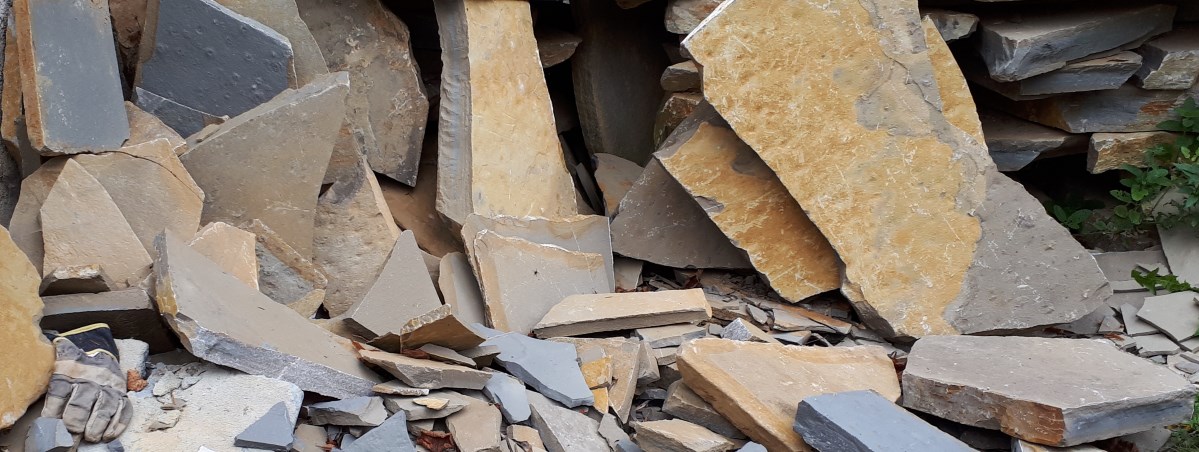

HI, thanks for the great article. I found he sharpening stone through Dictum tools catalogue.
There was an industry in Ireland ( where I am from) and a TV program was made in 1980. Here is a link if you’re interested:
https://www.youtube.com/watch?v=ek1k5vV-ySs
Hi Adrian, thanks for your comment. And many thanks for the link, I enjoyed it greatly! This shows a great example of oldfashioned handmade quality.
The type of stone you found at Dictum is indeed a similar scythe stone (I did not even know they still sell them these days). The Rozsutec stone is also made as a benchstone, traditionally fit for sharpening straight razors and other knives that should be scary sharp. Thanks again, and enjoy life!